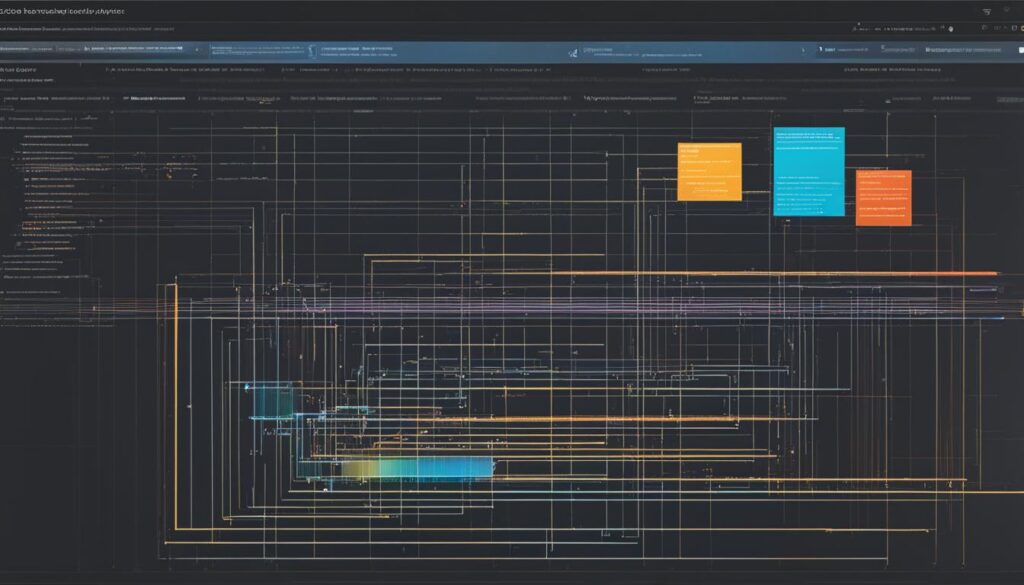Resources and Training
Enhance Code Quality with Static Code Analysis

In the field of software development, the significance of code quality cannot be overstated. It plays a crucial role in the reliability, efficiency, and security of the software we develop. This is why static code analysis is so important. By using this effective method, we can improve the quality of our code by detecting errors, enhancing performance, and adhering to secure coding practices.
Static code analysis allows us to catch potential issues early in the development process. By analyzing the source code without executing it, we can identify bugs and vulnerabilities, ensuring a higher level of code quality. With the help of code review tools and automated testing, we can implement software engineering best practices and achieve robust and efficient code.
Key Takeaways:
- Static code analysis is a powerful tool for enhancing code quality in software development.
- It enables early bug detection, performance optimization, and enforcement of secure coding practices.
- Code review tools and automated testing play a crucial role in implementing static code analysis.
- By incorporating static code analysis into our development process, we can achieve higher code quality and efficiency.
- Static code analysis is an essential practice for software engineering best practices and cost savings in bug fixes.
What is Static Code Analysis?
Static code analysis is a crucial process in software development that enables us to examine the source code for potential issues before it is executed. By analyzing the code directly, static code analysis helps us identify vulnerabilities, errors, and deviations from coding standards, allowing for early detection of issues and ensuring compliance with industry best practices.
Through static code analysis, we can achieve code consistency, improve code security, and save costs by addressing issues early in the development cycle. By detecting and resolving vulnerabilities at an early stage, we can prevent potential security breaches and enhance the overall quality of our software.
This process plays a vital role in maintaining coding standards and reducing the risk of coding errors. By employing static code analysis techniques, we can identify and rectify potential issues in the source code, such as coding flaws, coding rule violations, and other vulnerabilities.
Static code analysis is an essential component of software testing as it helps us detect and fix issues at the earliest stage of development. By leveraging the power of static code analysis, we can ensure the reliability, security, and maintainability of our software applications.
Incorporating static code analysis into our software development practices enables us to deliver high-quality code, eliminate potential vulnerabilities, and achieve greater efficiency in the development process. By proactively addressing issues and adhering to coding standards, we can build robust and secure software applications that meet the highest industry standards.
How Static Code Analysis Works
Static code analysis is a crucial part of the software development process, helping developers improve code quality and identify potential issues before execution. It involves a series of steps that begin with the input of source code files into a static analysis tool.
The first step in static code analysis is the scanning of the source code by a compiler. The compiler breaks down the code into tokens and creates an abstract syntax tree (AST), which represents the structure of the code.
Once the AST is created, the static analysis tool performs various code checks to identify potential issues. These checks include:
- Syntax Analysis: This involves examining the code for syntax errors and violations of coding standards.
- Data Flow Analysis: It tracks the flow of data through the code to detect issues such as uninitialized variables and data race conditions.
- Control Flow Analysis: This analysis examines the program’s control flow paths to identify bugs like infinite loops and unreachable code.
- Security Vulnerability Analysis: It checks for potential security vulnerabilities, such as buffer overflows and injection attacks.
After analyzing the code, the static analysis tool generates a report that highlights the issues found, often with a severity rating. This report provides developers with actionable information to improve code quality, prioritize fixes, and ensure the overall reliability and security of the software.
By following these steps, static code analysis plays a crucial role in preventing potential bugs, improving code quality, and ensuring the overall efficiency and reliability of software development.
Benefits of Static Code Analysis
Static code analysis provides numerous advantages for software development teams. By leveraging this technique, we can achieve code consistency, enhance code security, save costs, improve code maintainability, and elevate overall code quality.
Ensuring Code Consistency and Best Practices
“Consistency is the key to successful software development.”
Static code analysis enforces coding standards and best practices across the entire codebase. It helps identify deviations from established guidelines and ensures consistent coding styles and patterns. By adhering to these standards, teams can develop cleaner and more maintainable code, leading to increased efficiency and better collaboration.
Enhancing Code Security
“A secure code is a strong fortress.”
Security vulnerabilities can be costly and damaging. Static code analysis helps identify potential security risks and vulnerabilities early in the development process by scanning the code for weaknesses and insecure practices. By proactively detecting and addressing these issues, we can significantly reduce the risk of data breaches, safeguard sensitive information, and protect our applications and users.
Saving Costs
“Prevention is better than cure when it comes to software development.”
Static code analysis plays a vital role in detecting and fixing issues early in the development lifecycle. By identifying bugs, code smells, and potential performance bottlenecks before deployment, we can save significant costs associated with bug fixes, debugging, and maintenance. Moreover, addressing issues early minimizes the risk of downstream dependencies, reducing the complexity and expenses of resolving complex issues later on.
Improving Code Maintainability
“Code should be written for humans first, and computers second.”
Static code analysis helps improve code maintainability by detecting and suggesting improvements for code readability, duplication, and complexity. By addressing these code quality issues, developers can ensure that the codebase remains clean and scalable throughout the software’s lifecycle. This leads to reduced technical debt, easier code review processes, and smoother future enhancements and updates.
Elevating Code Quality
Static code analysis assists in achieving higher code quality by identifying potential issues early on. By scanning the codebase for bugs, potential errors, and non-compliant practices, we can ensure that the code meets the highest standards of reliability and performance. With improved code quality, we can deliver robust and efficient software that satisfies user expectations and industry standards.
Overall, static code analysis significantly contributes to the success of software development projects. It promotes code consistency, enhances code security, saves costs, improves code maintainability, and elevates code quality, leading to efficient and reliable software products.
| Benefits of Static Code Analysis |
|---|
| Code Consistency |
| Code Security |
| Cost Savings |
| Code Maintainability |
| Code Quality |
Potential Limitations of Static Code Analysis
Static code analysis is a valuable tool that helps improve code quality and reliability in software development. However, it is essential to understand the potential limitations of this technique to effectively leverage its benefits. Here are some key limitations to consider:
False Positives
False positives occur when static code analysis tools flag code segments as problematic, even though they are not. This can result in wasted time and effort spent investigating and addressing non-existent issues.
False Negatives
On the other hand, false negatives occur when static code analysis fails to detect actual issues in the code. This can lead to undetected bugs or security vulnerabilities, posing potential risks and compromising the overall code quality.
Tool Limitations
Static code analysis tools have limitations based on their rulesets and capabilities. Some tools may miss certain types of issues or have limited coverage for specific programming languages or frameworks. It’s crucial to choose the right tool that aligns with your project’s requirements and consider using multiple tools when necessary.
To overcome these limitations, software development teams should combine static code analysis with other testing techniques, such as dynamic testing and manual code review. This multi-faceted approach ensures comprehensive code quality assurance and reduces the risk of missing critical issues.
By understanding the potential limitations and complementing static code analysis with other methods, we can maximize its benefits and achieve higher code quality in software development.
Best Practices for Effective Static Code Analysis
At [Company Name], we believe that maximizing the effectiveness of static code analysis requires a multi-faceted approach. While static code analysis is a powerful tool for improving code quality, it can be further enhanced when used in combination with other testing techniques and the establishment of internal code quality standards.
Dynamic Testing
Dynamic testing involves running the software and executing various test cases to observe its behavior. By complementing static code analysis with dynamic testing, we can uncover runtime issues and validate the functionality of the code in real-world scenarios. This testing approach provides additional layers of assurance and helps identify potential issues that static code analysis may miss.
Manual Code Review
While automated static code analysis tools are valuable, human intelligence and manual code review play an essential role in identifying complex issues and assessing code quality. Manual code review allows developers to dive deep into the codebase, inspecting the logic, structure, and implementation details that automated tools may overlook. By performing thorough code reviews, we can ensure that the code adheres to coding standards, best practices, and specific project requirements.
Human Testing
Human testing, often performed by quality assurance (QA) professionals or user acceptance testers, involves evaluating the software from an end-user perspective. By incorporating human testing into the testing process, we can assess the software’s usability, functionality, and overall user experience. Human testers can provide valuable feedback, identify usability issues, and validate the software’s behavior against real-world user scenarios.
Code Quality Standards
Establishing internal code quality standards and guidelines is crucial for effective static code analysis. These standards provide a set of rules and best practices that developers should follow, ensuring consistency, maintainability, and readability of the codebase. By adhering to code quality standards, we can minimize code issues, enhance code maintainability, and streamline the development process.
“Combining static code analysis with dynamic testing, manual code review, and human testing enables us to maximize code quality and deliver robust software that meets our clients’ expectations.”
To illustrate the effectiveness of utilizing multiple testing techniques, we have created a table outlining the comparison between static code analysis, dynamic testing, manual code review, and human testing:
| Testing Technique | Advantages | Limitations |
|---|---|---|
| Static Code Analysis | – Early detection of code issues – Scalable for large codebases – Automated and efficient |
– Limited coverage on runtime behaviors – False positives or negatives may occur |
| Dynamic Testing | – Evaluates software in real-world scenarios – Uncovers runtime issues – Validates functionality |
– Time-consuming and resource-intensive – Requires careful test case design – Can’t check 100% of code paths |
| Manual Code Review | – Human intelligence for complex issues – Validates adherence to coding standards – Identifies logic flaws and implementation details |
– Subjective nature of reviews – Time-consuming for large codebases – Prone to human error |
| Human Testing | – Assesses user experience and usability – Validates software against real-world scenarios – Provides valuable user feedback |
– Requires diverse user perspectives – May overlook specific edge cases – Not comprehensive for large systems |
By combining these testing techniques and leveraging the insights gained from each approach, we can achieve comprehensive code quality assurance, faster development cycles, and ultimately deliver high-quality software that meets the needs of our clients and users.

Static Code Analysis Techniques Overview
Static code analysis encompasses several techniques for identifying potential problems in code. Let’s explore some of these techniques:
Syntax Analysis
Syntax analysis checks for syntax errors and coding standards violations in the code. It ensures that the code follows the correct syntax defined by the programming language, preventing common mistakes and improving code readability.
Data Flow Analysis
Data flow analysis tracks the flow of data through the code to detect issues such as uninitialized variables and data race conditions. By analyzing how data is used and modified within the code, data flow analysis helps identify potential bugs and logical errors.
Control Flow Analysis
Control flow analysis examines the program’s control flow paths to identify bugs like infinite loops and unreachable code. It helps developers understand how the program executes and identifies areas where code may not behave as expected.
Security Analysis
Security analysis focuses on identifying potential security vulnerabilities in the code. It checks for common security issues such as buffer overflows, injection attacks, and insecure cryptographic algorithms. By detecting these vulnerabilities early, developers can ensure that their code is secure and protected.
Using a combination of these static code analysis techniques, developers can proactively identify and address potential issues in their code, improving code quality and reducing the likelihood of bugs and security vulnerabilities.
- Syntax analysis checks for syntax errors and coding standards violations.
- Data flow analysis tracks the flow of data through the code to detect issues such as uninitialized variables and data race conditions.
- Control flow analysis examines the program’s control flow paths to identify bugs like infinite loops and unreachable code.
- Security analysis checks for potential security vulnerabilities, such as buffer overflows and injection attacks.
By leveraging these static code analysis techniques, developers can ensure that their code is robust, secure, and of high quality.
Static Code Analysis Tools
In the world of software development, static code analysis tools are invaluable resources for enhancing code quality and efficiency. These tools help developers identify and address potential issues in their code, resulting in more reliable and secure software. Let’s explore some popular static code analysis tools:
SonarQube
SonarQube is a comprehensive code quality management platform that supports a wide range of programming languages. It provides developers with continuous feedback on code quality, highlighting bugs, vulnerabilities, and code smells. SonarQube integrates seamlessly into existing development workflows, making it a popular choice among software teams.
Checkstyle
Checkstyle focuses on enforcing coding standards and conventions. It performs a variety of checks to ensure consistency in code formatting, naming conventions, and documentation. By integrating Checkstyle into the development process, teams can maintain a high level of code quality and readability.
FindBugs
FindBugs is a static code analysis tool that specializes in detecting potential bugs in Java programs. It analyzes bytecode to identify common coding mistakes, such as null pointer dereferences, resource leaks, and synchronization issues. FindBugs helps developers catch these bugs early, ensuring the production of robust and reliable Java code.
PMD
PMD is another popular static code analysis tool for Java codebases. It offers a set of rules and checks that target potential code flaws, poor coding practices, and other issues. PMD can be easily integrated into the development process, providing developers with actionable suggestions for improving code quality.
Veracode
Veracode is a comprehensive security-focused static code analysis tool. It not only identifies common vulnerabilities in code, but also offers guidance on remediation. Veracode supports multiple programming languages and provides an extensive library of security rules to ensure code is safe from potential attacks.
Coverity
Coverity is a static code analysis tool that focuses on identifying defects and security vulnerabilities in code. It offers deep code analysis capabilities, allowing developers to find even the most subtle issues. Coverity integrates with popular development environments, making it a valuable tool for teams looking to improve code quality.
ESLint
ESLint is a flexible and configurable static code analysis tool for JavaScript. It helps developers enforce coding standards, detect common programming errors, and identify potential issues. With its customizable ruleset, ESLint enables teams to tailor the analysis to their specific needs.
When selecting a static code analysis tool, software development teams must consider their specific needs, programming languages, and integration requirements. These tools play a crucial role in improving code quality, enhancing security, and maintaining efficient development processes. By leveraging the power of static code analysis tools, developers can create more reliable, secure, and high-quality software.
Static Code Analysis and Predictive Test Selection
In the world of software development, leveraging a combination of static code analysis and predictive test selection can greatly enhance the efficiency and effectiveness of the testing process. By harnessing the power of machine learning, predictive test selection analyzes past test results and predicts which tests are likely to fail in the future. This proactive approach enables us to focus our testing efforts on prioritized code areas that are most likely to contain issues.
By integrating predictive test selection with static code analysis, we are able to identify critical issues early on, allowing us to allocate our testing resources wisely. This not only saves time and effort but also helps us improve the overall quality of our software.
Why Static Code Analysis Matters
Static code analysis plays a vital role in the software development lifecycle. It helps us identify potential issues in the codebase without executing it, minimizing the risk of bugs and vulnerabilities. By analyzing the code directly, static code analysis detects coding errors, security vulnerabilities, and performance bottlenecks.
“Static code analysis allows us to catch potential issues early, enabling us to address them before they impact the functionality and reliability of our software.”
However, without proper prioritization, the testing process can become overwhelming and time-consuming. This is where predictive test selection comes into play, guiding us to focus our testing efforts on areas that require the most attention.
The Power of Predictive Test Selection
Predictive test selection leverages machine learning algorithms to anticipate potential issues in the code. By considering historical test results and analyzing patterns, it can predict which tests are likely to fail in the future. This capability allows us to prioritize testing efforts by identifying code areas that are more prone to issues.
This approach is particularly valuable in complex codebases where comprehensive testing is often unfeasible. By focusing our testing efforts on the most critical areas identified through predictive test selection, we can optimize our resources and improve the effectiveness of our testing process.
Improving Code Prioritization and Testing Efficiency
By combining static code analysis with predictive test selection, we can streamline the testing process, making it more efficient and targeted. Instead of exhaustively testing every line of code, we can prioritize our efforts and concentrate on the areas that matter most.
- Identify critical code areas: Predictive test selection helps us identify code areas that have a higher likelihood of containing issues, such as complex algorithms or frequently modified sections.
- Allocate testing resources: By focusing our testing efforts on these critical code areas, we can allocate our testing resources more effectively, ensuring thorough coverage where it is most needed.
- Early detection of issues: By catching potential issues in the early stages, we can address them before they escalate into full-blown bugs or vulnerabilities, reducing the overall impact on our software.
Ultimately, the combination of static code analysis and predictive test selection empowers us to improve code prioritization, optimize testing efficiency, and deliver high-quality software in a timely manner.
Implementing Static Code Analysis in High-Integrity Software Development
In high-integrity software development, static code analysis is a critical practice that ensures the reliability and quality of software. To achieve these goals, we rely on tools such as Polyspace code verifiers. These tools utilize formal methods to verify code written in C, C++, or Ada, enabling us to measure code complexity and verify compliance with coding standards.
One key benefit of static code analysis tools like Polyspace is their ability to perform change impact analysis. This analysis helps us assess how code changes may affect the reliability and functionality of other areas within the software. By identifying potential issues early on, we can mitigate risks and ensure the overall integrity of our development process.
Implementing static code analysis is particularly valuable in industries where safety and reliability certification is required. By utilizing tools like Polyspace, we can adhere to industry-specific standards and regulations, enhancing the resilience and robustness of our software.
| Benefits of Implementing Static Code Analysis in High-Integrity Software Development |
|---|
| Ensures the reliability and quality of software |
| Identifies potential issues early on, reducing risks |
| Assesses the impact of code changes on reliability and functionality |
| Helps adhere to industry-specific standards and regulations |
By incorporating static code analysis into our high-integrity software development process, we can enhance the overall quality and reliability of our software, ensuring it meets the stringent requirements of our industry.

The Importance of Static Code Analysis in Software Development
Static code analysis is an essential practice in software development that significantly contributes to code quality, bug detection, reliability, security, and cost savings. By leveraging static code analysis, we can catch potential issues early in the development process and enforce coding standards, leading to the delivery of high-quality software.
One of the key advantages of static code analysis is the ability to detect bugs before they become critical problems. By analyzing the code without executing it, static code analysis identifies potential vulnerabilities and issues, allowing developers to address them promptly. This proactive approach enhances software reliability and reduces the risk of failures later on.
Furthermore, static code analysis plays a crucial role in ensuring code security. By scanning the code for security vulnerabilities such as buffer overflows or injection attacks, it helps identify potential weaknesses and enables developers to implement necessary security measures. This proactive approach enhances the overall security posture of the software and mitigates the risk of data breaches.
Implementing static code analysis as a standard practice in software development also leads to significant cost savings. By addressing issues early in the development cycle, developers save time and resources that would otherwise be spent on cumbersome bug fixes later on. Additionally, static code analysis helps identify inefficient code patterns and performance bottlenecks, enabling developers to optimize the code for better performance, which may result in reduced hardware and infrastructure costs.
By incorporating static code analysis into our development process, we achieve more efficient and reliable software. Static code analysis helps us deliver high-quality code, detect and fix bugs early, enhance reliability, ensure security, and achieve cost savings. With its ability to enforce coding standards and catch potential issues at an early stage, static code analysis is an invaluable tool in the modern software development lifecycle.
Conclusion
In conclusion, static code analysis is a powerful tool that greatly enhances code quality and efficiency in software development. By employing static code analysis, we can identify potential issues early in the development process, catching bugs and performance optimization opportunities before they become costly problems. Additionally, static code analysis enforces secure coding practices, allowing us to address security vulnerabilities and protect sensitive data.
The benefits of static code analysis are far-reaching. Not only does it improve the reliability and security of software, but it also leads to significant cost savings by reducing the need for expensive bug fixes and speeding up the development cycle. By incorporating static code analysis into our software engineering best practices, we can unlock higher code quality and efficiency, delivering robust and high-performing software to our clients.
Furthermore, automated testing plays a vital role in the static code analysis process. By automating the testing phase, we can detect issues more efficiently and free up valuable time for developers to focus on critical tasks. This combination of static code analysis and automated testing allows us to achieve comprehensive code quality assurance, resulting in software that is reliable, secure, and of the highest standard.
Static code analysis is a process used in the early stages of software development to examine the source code for potential issues. It helps identify vulnerabilities, errors, and deviations from coding standards before the code is executed.
Static code analysis starts with the input of source code files into a static analysis tool. The compiler scans the source code, breaking it down into tokens and creating an abstract syntax tree (AST). The static analysis tool then performs various code checks, including syntax analysis, data flow analysis, control flow analysis, and security vulnerability analysis.
Static code analysis helps enforce code consistency, improves code security, saves costs by detecting and fixing issues early, improves code maintainability, and overall code quality.
Static code analysis can have false positives and false negatives, and its effectiveness may depend on the rulesets and capabilities of the tools used. It is important to use static code analysis in conjunction with other testing techniques for comprehensive code quality assurance. To maximize the effectiveness of static code analysis, it should be used in combination with other testing techniques such as dynamic testing, manual code review, and human testing. Establishing internal code quality standards and guidelines further enhances the effectiveness of the process.
Static code analysis techniques include syntax analysis, data flow analysis, control flow analysis, and security analysis. These techniques help identify syntax errors, uninitialized variables, infinite loops, unreachable code, and potential security vulnerabilities.
Popular static code analysis tools include SonarQube, Checkstyle, FindBugs, PMD, Veracode, Coverity, and ESLint. These tools support different programming languages and offer a range of features.
Predictive Test Selection uses machine learning to analyze past test results and predict which tests are likely to fail in the future. When combined with static code analysis, it helps prioritize testing efforts and improves the efficiency and effectiveness of the testing process.
In high-integrity software development, tools like Polyspace code verifiers use formal methods to verify code, measure code complexity, and check compliance with coding standards. They can also perform change impact analysis to assess how code changes may affect reliability and functionality. Static code analysis is important in software development as it enhances code quality, detects bugs, improves reliability and security, saves costs, and ensures the delivery of high-quality software.
FAQ
What is static code analysis?
How does static code analysis work?
What are the benefits of static code analysis?
What are the potential limitations of static code analysis?
What are the best practices for effective static code analysis?
What are the different static code analysis techniques?
What are some popular static code analysis tools?
How does static code analysis work with predictive test selection?
How is static code analysis implemented in high-integrity software development?
Why is static code analysis important in software development?
At the helm of our content team is Amelia, our esteemed Editor-in-Chief. Her extensive background in technical writing is matched by her deep-seated passion for technology. Amelia has a remarkable ability to distill complex technical concepts into content that is not only clear and engaging but also easily accessible to a wide range of audiences. Her commitment to maintaining high-quality standards and her keen understanding of what our audience seeks are what make her an invaluable leader at EarnQA. Under Amelia’s stewardship, our content does more than just educate; it inspires and sets new benchmarks in the realm of QA education.
Resources and Training
Your Path to Success: The Insider’s Guide to Getting Certified as a Quality Assurance Software Analyst!
Looking to get certified as a Quality Assurance Software Analyst? Here's a guide to help you navigate the process and achieve your goal in the field of software quality assurance.

For those working in the software industry, gaining certification as a Quality Assurance Software Analyst can feel like solving a difficult puzzle. With various certification options and required qualifications, understanding the path to achieving this important career milestone is crucial.
Whether you’re looking to enhance your current role or explore new opportunities, the path to certification is an essential aspect of professional growth. Understanding the intricacies of certification programs and the benefits they offer can help pave the way for a successful career in quality assurance.
Key Takeaways
- Certified Manager of Software Quality (CMSQ) and Certified Software Quality Analyst (CSQA) certifications can enhance professional standing in the field of software quality assurance.
- CSQA certification requires either 4 years of full-time experience or a degree from an accredited college.
- When choosing a certification program, look for well-recognized certifications such as CSTE, CASQ, and CMSQ, and evaluate the curriculum alignment with QA software testing and project management.
- To prepare for the certification exam, familiarize yourself with the exam content, format, and requirements, take relevant E-Courses, and use sample exams for self-evaluation and identifying areas for improvement.
Understanding Software Quality Assurance Certifications
Understanding the landscape of software quality assurance certifications provides valuable insight into the various pathways and qualifications available for professionals seeking to validate their expertise in this critical field.
As Quality Assurance Analysts, pursuing certifications such as the Certified Manager of Software Quality (CMSQ) or the Certified Software Quality Analyst (CSQA) can significantly enhance our professional standing. These certifications not only demonstrate our commitment to excellence in Testing and Software Quality Assurance but also showcase our dedication to ongoing career development.
Acquiring a certification as a Certified Software Quality Analyst requires a combination of experience and education. Professionals need to have a minimum of four years of full-time experience in a relevant field, such as information services, to be eligible for the CSQA certification. Additionally, possessing a degree from an accredited college or university can substitute for some of the required experience.
The CSQA certification exam covers various aspects of Software Quality Assurance, including Quality Principles and Concepts, Quality Leadership, and Quality Control.
Choosing the Right Certification Program

As Quality Assurance Analysts, our next step is to carefully evaluate the available certification programs for quality assurance software analysts in order to make an informed decision about which program aligns best with our professional goals and industry recognition.
- Reputation and Recognition: Look for certifications such as Certified Software Tester (CSTE), Certified Associate in Software Quality (CASQ), and Certified Manager of Software Quality (CMSQ) that are well-recognized within the industry.
- Curriculum Alignment: Evaluate the curriculum and content of the certification program to ensure it covers essential aspects of QA software testing, ISTQB certification, and project management, aligning with your career goals.
- Practical Experience and Training: Consider certification programs that offer practical experience and hands-on training, as this can significantly enhance your skills and readiness for real-world scenarios.
Careful consideration of these factors will enable us to select a certification program that not only provides industry recognition but also equips us with the knowledge and skills necessary for success in the field of quality assurance software analysis.
Preparing for the Certification Exam
In our preparation for the certification exam, it’s crucial to thoroughly familiarize ourselves with the exam content, format, and requirements before proceeding with our study plan. Understanding the number of questions, passing score, and duration of the exam is essential.
Additionally, taking an E-Course that covers the necessary topics for the certification exam, such as those outlined by the International Software Testing Qualifications Board (ISTQB), can provide a comprehensive understanding of quality assurance concepts and methodologies.
Using sample exams to evaluate our knowledge and identify areas for improvement is also a recommended practice. When considering E-Course options, it’s important to explore different pricing and package options, which may include benefits such as hard copy certificates and digital badges upon successfully passing the exam.
Furthermore, ensuring that we meet the prerequisites and educational requirements for the certification is crucial. It’s important to be prepared for a proctored online exam, which typically prohibits the use of external sources.
With these preparations in place, we can confidently work towards obtaining our professional certificate as a quality assurance software analyst.
Maintaining Your Certification

To maintain our certification as a Certified Quality Assurance Software Analyst, we must actively engage in ongoing training and education to stay updated with industry standards and best practices. This ensures that we maintain a professional level of competence and stay aligned with the evolving landscape of software development and engineering.
- Complete Continuing Education: Engaging in online courses, workshops, and seminars related to Quality Assurance (QA) and software development is crucial for staying abreast of the latest trends and methodologies.
- Renew Your Certification: It’s imperative to fulfill renewal requirements, which may include earning continuing education credits or undergoing re-examination to ensure the validity of our certification.
- Stay Informed: Remaining vigilant about any changes or updates to certification requirements and processes is essential for maintaining our certification’s relevance and value.
Advancing Your Career as a Certified Quality Assurance Analyst
With a software quality assurance certification, we can pave the way for career advancement and industry recognition. It’s essential to continuously seek opportunities for professional growth and development. One way to advance our career as a certified quality assurance analyst is to consider pursuing advanced certifications, such as ISTQB Advanced-Level Certifications for Test Analysts and Test Managers. These certifications focus on specialized areas within quality assurance and can enhance our competence in specific roles.
Additionally, gaining practical work experience in quality assurance and software testing, coupled with pursuing higher education, such as a degree in management or Software Testing Qualifications, can significantly contribute to career advancement.
Active involvement in a professional group related to quality assurance and software testing can also provide valuable networking opportunities and access to the latest industry trends and best practices. Furthermore, obtaining certifications like CSQA can demonstrate our commitment to excellence in quality assurance and further solidify our credentials in the field.
Frequently Asked Questions
How Do I Become a Certified Quality Analyst?
To become a certified quality analyst, we need to research and choose a reputable certification program, like ISTQB Tester or CSQA, that aligns with our career goals.
Next, we should thoroughly review the qualifications, prerequisites, and exam structure for the chosen certification.
Then, we need to prepare diligently by studying the course materials, taking practice exams, and seeking mentorship if available.
What Are the Qualifications to Be a Software Quality Assurance Analyst?
Qualifying as a software quality assurance analyst demands a bachelor’s in computer science, plus a professional certification such as CAST, ISTQB Tester, CSTE, CSQA, or CMSQ.
Internships or entry-level positions provide practical experience, while advanced analytical and problem-solving skills, programming language proficiency, and industry knowledge are key.
Staying abreast of trends through workshops and continuous education programs is vital.
It’s a rigorous path, but the rewards are worth it.
What Certification Should I Get to Be Qa?
We should aim for the ISTQB Foundation Level Certification as a starting point. It provides a solid foundation in software testing principles and terminology.
After gaining experience, pursuing the ISTQB Advanced-Level Certifications for Test Analysts or Test Managers would be beneficial for career advancement.
Additionally, the CSQA Certification is recognized in the industry and demonstrates expertise in quality assurance and testing processes.
These certifications can enhance our skills and employability as QA professionals.
How Long Does It Take to Get a QA Certification?
We’ve discovered that the duration to acquire a QA certification varies widely, akin to navigating an intricate maze. The time frame depends on the specific certification program chosen and an individual’s prior knowledge and experience.
For instance, ISTQB offers foundational, advanced, and expert-level certifications, each with different preparation and examination commitments. Similarly, CSQA certification involves a 20-25 hour E-course and a 90-minute exam.
It’s crucial to consider these factors when planning the certification timeline.
Conclusion
In conclusion, pursuing a certification in Quality Assurance Software Analysis is like sharpening our tools in a craftsman’s workshop. It allows us to hone our skills, showcase our expertise, and open up new opportunities in our career.
By carefully selecting the right certification program, diligently preparing for the exam, and maintaining our certification, we can continue to advance our career as a certified quality assurance analyst.
It’s a journey towards mastery that’s both challenging and rewarding.
At the helm of our content team is Amelia, our esteemed Editor-in-Chief. Her extensive background in technical writing is matched by her deep-seated passion for technology. Amelia has a remarkable ability to distill complex technical concepts into content that is not only clear and engaging but also easily accessible to a wide range of audiences. Her commitment to maintaining high-quality standards and her keen understanding of what our audience seeks are what make her an invaluable leader at EarnQA. Under Amelia’s stewardship, our content does more than just educate; it inspires and sets new benchmarks in the realm of QA education.
Resources and Training
Boost Your Career Now: Essential Secrets to SQA Certification and Training Revealed!
Get essential SQA certification and training to advance your career. Learn the key skills and knowledge needed to succeed in software quality assurance.

If you have ever come across a malfunctioning app on your phone or encountered a glitch on a website, that is the perfect time to explore **SQA Certification and Training Essentials**.
As professionals in the software quality field, we understand the value of staying current with the latest industry standards and best practices. But what sets these certifications apart? How do they compare to other well-known software testing certifications?
Let’s explore the importance of SQA Certification and the key training essentials that pave the way for career growth in the software quality domain.
Key Takeaways
- SQA Certification and Training Essentials provide a comprehensive understanding of quality assurance practices in software development.
- These certifications equip individuals with essential knowledge and skills for effective software testing, including test automation and performance testing.
- They complement other software testing certifications, enhancing overall proficiency and demonstrating commitment to mastering software testing essentials.
- SQA Certification offers easy recertification options to stay updated with industry standards and advancements in software quality assurance.
Importance of SQA Certification

Obtaining SQA certification is crucial for ensuring a comprehensive understanding of quality assurance practices within the software development process. The importance of SQA certification can’t be overstated. It equips individuals with the essential knowledge and skills required to perform software testing effectively. SQA certification introduces key testing areas such as test automation and performance testing, which are essential for ensuring the quality and reliability of software products.
Moreover, it complements other software testing certifications such as ISTQB certification exams, enhancing the overall proficiency of individuals in the field of software testing.
Furthermore, SQA certification offers individuals the opportunity for easy recertification, allowing them to stay updated with the latest industry standards and best practices. This ensures that certified individuals remain at the cutting edge of software testing essentials, thereby enhancing the quality of their work.
Additionally, SQA certification adds individuals to the Official U.S. List of Certified Testers, significantly elevating their profile within the industry.
Key Training Essentials

Discussing key training essentials for software quality assurance (SQA) involves understanding the core components necessary for comprehensive proficiency in the field.
In the realm of software quality, training in various types of testing is crucial. This includes software testing certification, cybersecurity testing, test automation, performance testing, and usability testing.
A vital aspect of training is obtaining certification, such as the ISTQB registry, to validate one’s expertise and knowledge in software testing. The AT*Learn course is an excellent resource for preparing for the AT*SQA Testing Essentials exam, providing affordable and comprehensive exam preparation. Additionally, free resources like the syllabus, sample exam, and sample exam answers are available for AT*SQA Testing Essentials exam preparation.
The training essentials cater to a broad audience, including Scrum team members, Test Automation Engineers, Performance Test Engineers, Developers, Business Analysts (BAs), Software Specialists, and DevOps Team Members.
The AT*SQA Testing Essentials Body of Knowledge covers crucial topics such as Lightweight Testing, DevOps Testing, Introduction to Testing, DevOps Pipeline, and the Role of Automation in DevOps Testing.
With flexible recertification options, professionals can ensure they stay updated and maintain their proficiency in software quality assurance.
Career Benefits of SQA Certification
Acquiring SQA Certification enhances the professional qualifications and skills of individuals in the software industry, providing numerous career benefits.
Software Testers who obtain SQA Certification can complement other certifications such as ISTQB SCR, strengthening their qualifications and demonstrating a commitment to mastering software testing essentials.
This certification equips individuals with comprehensive software testing knowledge, including crucial areas such as test automation and performance testing, which are highly valued in the industry.
Additionally, successful completion of the SQA Certification exam enables individuals to be listed on the AT*Work™ list of testers, enhancing their professional profile and visibility within the industry.
Moreover, the certification offers easy recertification options, ensuring that individuals can stay up-to-date with the latest advancements in software quality assurance.
Ultimately, SQA Certification not only validates an individual’s skills and expertise but also opens up new career opportunities and positions them as valuable assets within the software testing domain.
AT*SQA Testing Essentials Exam Guide

The AT*SQA Testing Essentials Exam Guide presents a comprehensive framework for individuals seeking to validate their software testing expertise and stay current in the field. This certification is beneficial for those looking to enhance their career prospects and demonstrate their advanced testing skills.
The Testing Essentials Certification, offered by AT*SQA, is designed to complement existing certifications, such as ISTQB and ASTQB. The AT*SQA Testing Essentials Body of Knowledge covers essential topics like Lightweight Testing and Introduction to Testing, providing a well-rounded understanding of foundational concepts.
The exam itself consists of 65 questions and has a 120-minute time limit (150 minutes for non-native English speakers), offering a thorough assessment of an individual’s knowledge and skills in software testing.
Moreover, AT*SQA offers a range of software testing certifications, including DevOps Testing Certification and IoT and Mobile Testing Certification, catering to diverse specializations within the field. This certification is an official U.S. certification, and successful candidates are listed on the official List of Certified Testers, demonstrating their credibility in the industry.
For those interested in pursuing the AT*Essentials certification or seeking more information, they can contact us for further guidance.
Comparison of Software Testing Certifications
We can gain a better understanding of software testing certifications by comparing the features and requirements of various certifications available, building on the comprehensive framework provided by the AT*SQA Testing Essentials certification.
When comparing software testing certifications, several factors come into play:
- ISTQB Exam: This certification is globally recognized and focuses on the fundamental principles of software testing, making it suitable for those seeking international opportunities.
- Local Software Testing Resources: Some certifications, like AT*SQA Testing Essentials, offer local resources and support, making it easier to access study materials and networking opportunities.
- Connected Devices: With the rapid expansion of the Internet of Things, certifications that include testing for connected devices, such as the CSTE and CSTP, can be valuable for testers specializing in this area.
- Tiers® Software Tester Rankings: Certain certifications, like ASTQB, are associated with Tiers® software tester rankings, providing a structured career path for testers to progress within the industry.
Frequently Asked Questions
What Is the Full Form of Sqa?
We believe the full form of SQA is ‘Software Quality Assurance.
It encompasses the entire software development life cycle and aims to ensure that the software meets defined standards, procedures, and methodologies.
The main objective is to prevent defects and improve development processes.
SQA involves implementing processes and standards to achieve the desired quality in the final software product.
What Is Cast Certification?
We’ve found that CAST certification, a widely recognized credential in software testing, covers various testing areas, such as test automation and performance testing. It’s suitable for professionals like test engineers, developers, and business analysts.
To achieve CAST certification, individuals need to pass a 65-question exam within 120 minutes. Additional time is provided for non-native English speakers.
Recertification options are available to keep professionals updated with the latest advancements in software testing.
What Do You Mean by Testing in Software Engineering?
In software engineering, testing refers to the evaluation process of a software application to uncover defects or bugs. It encompasses various techniques like black box testing, white box testing, and automation to ensure the software meets quality standards.
Performance testing is also vital, focusing on evaluating system responsiveness and stability.
Additional domains of testing include cybersecurity, usability, and DevOps testing, emphasizing the integration of testing in the development process.
What Is Objective of Testing in Software Engineering?
We ensure software products meet quality standards and perform as expected. Testing identifies defects and bugs, ensuring reliable end products that validate specified requirements and user expectations.
Our goal is to improve software quality, reliability, and performance through systematic and thorough testing processes. By building trust in the software, we ensure it’s free of critical issues and operates as intended.
Conclusion
In conclusion, SQA Certification and Training Essentials serve as the compass guiding us through the ever-changing landscape of software quality. With its comprehensive program and flexible recertification options, it equips us with the necessary tools to navigate the complex world of software testing.
Just as a lighthouse guides ships safely to shore, SQA Certification and Training Essentials illuminate the path for testers, enabling them to excel in their roles and stay ahead of the curve in the industry.
At the helm of our content team is Amelia, our esteemed Editor-in-Chief. Her extensive background in technical writing is matched by her deep-seated passion for technology. Amelia has a remarkable ability to distill complex technical concepts into content that is not only clear and engaging but also easily accessible to a wide range of audiences. Her commitment to maintaining high-quality standards and her keen understanding of what our audience seeks are what make her an invaluable leader at EarnQA. Under Amelia’s stewardship, our content does more than just educate; it inspires and sets new benchmarks in the realm of QA education.
Resources and Training
Unveiling the Critical Role: Why a Quality Assurance Tester is Indispensable in Every Software Development Team!
A quality assurance tester is crucial for ensuring software quality. They identify issues, improve user experience, and maintain the software's integrity, ultimately leading to a better end product.

Have you ever thought about why a quality assurance tester is essential for a software development team?
The role of a QA tester goes beyond just finding and reporting bugs. It encompasses a comprehensive approach to ensuring that the software meets quality standards and performs as expected.
From validating functionality to assessing user experience, a QA tester’s contribution is integral to the success of any software project. But what specific aspects make their involvement so crucial?
Let’s explore the significance of having a dedicated QA tester and the impact it has on the overall software development process.
Key Takeaways
- QA testers play a crucial role in ensuring the quality, functionality, and performance of software.
- They collaborate closely with stakeholders, design test cases, and identify and document defects encountered during testing.
- QA testers maintain comprehensive documentation of test cases, scenarios, and results, and analyze test data to generate reports for stakeholders.
- Having a QA tester on the software development team is essential to prevent bugs and errors, streamline the development process, and deliver high-quality software that meets end-user expectations.
Importance of Quality Assurance Tester
As vital members of the software development team, Quality Assurance Testers play a crucial role in ensuring the quality, functionality, and performance of the software. Our dedicated quality assurance team is integrated into the software development pipeline to identify and address any issues that may compromise the final product. By incorporating QA testing throughout the development process, we ensure that the product meets the highest standards of quality and functionality.
In our role as QA testers, we’re responsible for defining the scope of testing based on project requirements and collaborating closely with project stakeholders to understand their needs. Through meticulous testing, we contribute to the detection and resolution of defects, reducing risks and enhancing overall user satisfaction. Our work is essential in guaranteeing that the software not only meets the specified requirements but also delivers an exceptional user experience.
The QA tester’s role extends beyond mere bug detection; it’s an integral part of delivering high-quality software that aligns with the demands of the market and the expectations of end-users.
Role in Software Testing

Playing a pivotal role in ensuring the quality and functionality of the software, QA testers closely collaborate with project stakeholders to define testing scope and align with project goals and requirements. They play a critical role in the software development process by designing and creating test cases based on functional and non-functional specifications, ensuring comprehensive coverage of software features.
Furthermore, QA testers identify and document defects encountered during testing, providing valuable feedback for improvement and resolution. They also maintain comprehensive documentation of test cases, scenarios, and results, ensuring traceability and thorough testing coverage.
Additionally, QA testers analyze test data, generate reports, and communicate findings to project stakeholders, contributing to informed decision-making and continuous improvement. Their expertise in testing tools and automation aids in efficient and effective QA testing.
Skills and Expertise Required
In ensuring the quality and functionality of software, a quality assurance tester must possess a meticulous attention to detail, strong analytical skills, and effective communication abilities for collaboration with the development team.
Attention to detail is crucial for meticulously examining all aspects of the software and identifying potential issues.
Strong analytical skills are essential for analyzing code, functions, and interactions to ensure the software functions as intended.
Effective communication skills are vital for reporting issues and collaborating with the development team to address them.
Additionally, technical proficiency in testing methodologies, tools, and automation is necessary for creating and executing test cases efficiently.
The ability to understand and utilize automation tools enhances the effectiveness and efficiency of testing processes.
Problem-solving abilities are also important for a quality assurance tester, as they need to find solutions to challenges encountered during testing.
Tools and Technologies Used

With the emphasis on meticulous attention to detail, strong analytical skills, and effective communication abilities in the previous subtopic, the tools and technologies used by quality assurance testers play a pivotal role in ensuring the quality and functionality of software.
Test management tools like Jira, TestRail, or HP ALM are essential for creating and managing test cases and test plans.
Automation testing tools such as Selenium, Appium, or Ranorex streamline the process by automating repetitive test cases and regression testing.
Bug tracking and reporting tools like Bugzilla, Redmine, or Mantis are crucial for documenting and managing identified defects.
Additionally, performance testing tools such as JMeter, LoadRunner, or Apache Benchmark are used to evaluate software under various load conditions.
Version control systems like Git or SVN are also indispensable for managing and tracking changes in the software codebase.
These tools and technologies not only enhance the efficiency of the test team but also contribute to the overall success of the project by ensuring a high-quality product that meets the customer’s expectations.
Consequences of Not Having a QA Tester
The absence of a qualified QA tester in a software development team can lead to significant quality and functionality issues within the software product. Without a dedicated QA professional, the team may struggle to ensure the thorough testing of the software. This can result in an increased number of bugs and errors making their way into the final product.
The lack of a QA tester could also lead to a disjointed software development process, with potential issues in communication and coordination between different team members. This, in turn, may result in a less efficient development cycle and a higher likelihood of missed bugs and errors.
Furthermore, without a QA tester, the overall quality of the software may suffer, ultimately impacting the end-user experience. This can lead to dissatisfied customers, decreased user adoption, and potential reputational damage for the software development team and the organization as a whole.
Therefore, having a QA tester is crucial to not only catch and address bugs and errors but also to ensure an improved customer experience and the overall success of the software product.
Frequently Asked Questions
Why Is Quality Assurance Important in Software Development?
Quality assurance is critical in software development as it ensures the quality, functionality, and performance of the software. Through techniques like functional testing, regression testing, and performance testing, QA testing helps in detecting and fixing defects, reducing risks, and enhancing user satisfaction.
This integration throughout the software development lifecycle leads to high-quality software and exceptional user experience. Thus, quality assurance plays a pivotal role in ensuring the overall success of software development projects.
What Is the Role of QA Tester in Software Development?
We play a crucial role in software development by ensuring the highest quality of the product. Our responsibilities include:
- Defining testing scope
- Communicating with stakeholders and developers
- Finding potential issues that developers might overlook
We promote a collaborative culture where quality is a collective responsibility. Our dedicated focus on testing helps to identify and exploit potential problems, ensuring that the software meets the highest standards of quality and performance.
Why Is a Quality Assurance Tester Needed on a Software Development Team Quizlet?
We need a quality assurance tester on a software development team because they ensure the product meets high standards.
They conduct thorough testing to identify and fix any issues, ensuring a smooth user experience.
This ultimately saves time and resources by catching potential problems early in the development cycle.
Their expertise in finding and resolving bugs helps deliver a reliable, high-quality software product to our customers.
Why There Is the Need of Tester in Software Testing?
We believe testers play a crucial role in software testing by ensuring the quality, functionality, and performance of the software. They identify defects, maintain documentation, and collaborate with developers to provide valuable feedback and assist in the bug-fixing process.
This thorough and objective testing process helps validate software against requirements and improves overall quality, leading to customer trust, satisfaction, and cost savings.
Conclusion
In conclusion, having a quality assurance tester on a software development team is like having a safety net for the software. They catch the bugs and ensure the smooth functioning of the program, ultimately providing a better user experience.
Without a QA tester, the software is like a ship without a rudder, navigating blindly through potential hazards. It’s essential to have a dedicated QA tester to steer the software in the right direction and ensure its success.
Rick, our Software Quality Assurance Writer, is the creative force behind many of our insightful articles and course materials. His unique background in software development, fused with his natural flair for writing, allows him to convey complex QA concepts in a way that is both informative and captivating. Rick is committed to keeping abreast of the latest trends and advancements in software testing, ensuring that our content remains not just relevant, but at the forefront of the field. His significant contributions are instrumental in helping us fulfill our mission to deliver premier QA education.
-

 Fundamentals of SQA5 days ago
Fundamentals of SQA5 days agoHow Do You Structure a Quality Assurance Team?
-

 SQA Best Practices6 days ago
SQA Best Practices6 days agoElevate Your Tech with Software Quality Assurance
-

 SQA Techniques and Tools2 days ago
SQA Techniques and Tools2 days agoComprehensive Guide to Software Quality Assurance Strategies and Techniques in Development
-

 Fundamentals of SQA7 days ago
Fundamentals of SQA7 days agoUnderstanding Definition and Scope of Software Quality Assurance (SQA)
-

 SQA Best Practices2 days ago
SQA Best Practices2 days agoDefining Roles and Responsibilities in Software Quality Assurance (SQA) Teams: A Comprehensive Overview
-

 SQA Techniques and Tools6 days ago
SQA Techniques and Tools6 days agoExpert Usability Testing Strategies Revealed
-

 SQA Best Practices3 days ago
SQA Best Practices3 days agoUnderstanding KPIs in QA Testing: Key Metrics for Measuring Software Quality
-

 SQA Best Practices6 days ago
SQA Best Practices6 days agoTop SQA Best Practices for Quality Assurance











